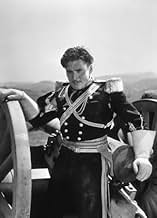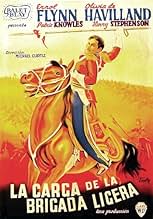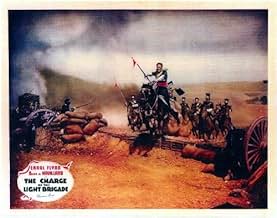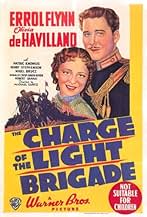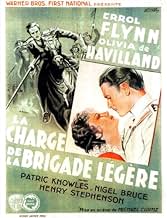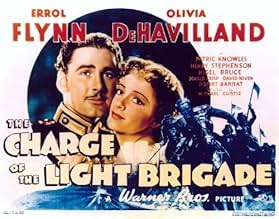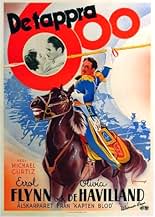CALIFICACIÓN DE IMDb
7.0/10
5.6 k
TU CALIFICACIÓN
Agrega una trama en tu idiomaA major countermands orders and attacks to avenge a previous massacre of men, women, and children.A major countermands orders and attacks to avenge a previous massacre of men, women, and children.A major countermands orders and attacks to avenge a previous massacre of men, women, and children.
- Ganó 1 premio Óscar
- 1 premio ganado y 3 nominaciones en total
G.P. Huntley
- Major Jowett
- (as G. P. Huntley Jr.)
J. Carrol Naish
- Subadar-Major Puran Singh
- (as J. Carroll Naish)
Princess Baba
- Prema's Mother
- (as Princess Baigum)
Argumento
¿Sabías que…?
- TriviaFor the filming of the climactic charge, one hundred twenty-five horses were trip-wired. Of those, twenty-five were killed outright or had to be put down afterward. The resulting public furor caused the US Congress to pass laws to protect animals used in motion pictures. Star Errol Flynn, a horseman, was so outraged by the number of horses injured and killed during the charge, and by director Michael Curtiz's seeming indifference to the carnage, that at one point as he was arguing with Curtiz about it, he could contain himself no more and actually physically attacked him. They were pulled apart before any serious damage was done, but it put a permanent freeze on their relationship; even though they made subsequent films together, they despised each other and would speak only when necessary on the set.
- ErroresAfter the massacre, Flynn sympathetically listens to Major Singh crying over the body of his murdered son Prema who is clearly wiggling his toes in the foreground of the scene.
- Citas
[first lines]
Sir Humphrey Harcourt: How do you fellows manage to look so comfortably, Vickers?
Major Geoffrey Vickers: We may look it Sir, but we're not. They say the first forty years are about the hottest up here on the frontier, after that you get used to it.
Sir Humphrey Harcourt: Really?
- Créditos curiososOpening credits: This production has its basis in history. The historical basis, however, has been fictionized for the purposes of this picture and the names of many characters, many characters themselves, the story, incidents and institutions, are fictitious. With the exception of known historical characters, whose actual names are herein used, no identification with actual persons, living or dead, is intended or should be inferred.
- Versiones alternativasAlso available in a computer colorized version.
- ConexionesFeatured in Hollywood and the Stars: The Swashbucklers (1964)
- Bandas sonorasGod Save the Tsar
(uncredited)
Music by Alexis Lvov
[The Russian national anthem from 1833 to 1917 played as part of the score during the charge at Balaklava]
Opinión destacada
Anyone who is expecting a factual retelling of the famous charge at the Battle of Balaclava in the Crimean War had better look to Tony Richardson's film from 1968. This particular Charge of the Light Brigade is a nice action adventure tale from the British Raj in the Kipling mold.
Of course this is all fictional. There's no such person as the evil Moslem ruler played by C. Henry Gordon who massacred a British garrison at a place called Chukoti in 1854. The reason for the famous cavalry charge did not happen so that the regiment could get to nail this dude for his crimes. Yet one thing I found contained more than an element of truth about British rule in India and some of our problems today.
At the very beginning Errol Flynn is accompanying E.E. Clive on a goodwill mission to Gordon. It seems as though there was a treaty with a promised subsidy from Her Majesty that expired with the death of his father. Even though they're not paying him any more to be the British friend, Clive still hopes for Gordon's friendship.
This in fact was how the British acquired 'friends' all over India, they ruled very little of it outright. They won a bidding war that was as acrimonious as the military conflict with other European powers which concluded with the French out of there altogether after the Seven Years War and the Portugese left with a couple of enclaves on the coast.
Clive in fact is one very large fathead, Flynn knows it only too well. In fact though this is how we're still acquiring 'friends' in that region which is now Pakistan.
Thrown into the politics is the rivalry between Errol Flynn and his brother Patric Knowles for Olivia DeHavilland. Originally Anita Louise was supposed to be slated for the part. But after the rave notices started coming in from Captain Blood before some of the romantic stuff was to be shot, Louise was substituted for Olivia DeHavilland and poor Olivia was typecast as the crinolined heroine until she left Warner Brothers.
Jack Warner spent a lot of money on this film. The whole garrison at Chukoti where the massacre took place was built from the ground, up; no miniatures were used. Thousands of horses were bought and about 200 were destroyed in the making of the final charge. So many animals were hurt the ASPCA stepped in and Charge of the Light Brigade got a lot of bad publicity among animal lovers. It did receive an Oscar for Best Assistant Director for the second unit work in depicting the charge when that was a category at the Academy Awards.
Errol Flynn said it was the roughest film he ever made in terms of pure physicality. It was pretty rough on Olivia DeHavilland as well who Flynn accidentally cold-cocked during a scene. These crinolined heroines do have it rough.
One of my favorite character actors, Henry Stephenson, plays the fictional Charles Masefield in this film. Stephenson in every film he did always embodied the stiff upper lip, attention to your duty ethic that the United Kingdom prides itself in. He's always a man of class and refinement. And he firmly believes in the John Ford mantra, when the legend becomes fact, print the legend.
Which is what Alfred Lord Tennyson gave us when he wrote that poem extolling the young men of that generation who died at Balaclava. We're watching the legend here.
Of course this is all fictional. There's no such person as the evil Moslem ruler played by C. Henry Gordon who massacred a British garrison at a place called Chukoti in 1854. The reason for the famous cavalry charge did not happen so that the regiment could get to nail this dude for his crimes. Yet one thing I found contained more than an element of truth about British rule in India and some of our problems today.
At the very beginning Errol Flynn is accompanying E.E. Clive on a goodwill mission to Gordon. It seems as though there was a treaty with a promised subsidy from Her Majesty that expired with the death of his father. Even though they're not paying him any more to be the British friend, Clive still hopes for Gordon's friendship.
This in fact was how the British acquired 'friends' all over India, they ruled very little of it outright. They won a bidding war that was as acrimonious as the military conflict with other European powers which concluded with the French out of there altogether after the Seven Years War and the Portugese left with a couple of enclaves on the coast.
Clive in fact is one very large fathead, Flynn knows it only too well. In fact though this is how we're still acquiring 'friends' in that region which is now Pakistan.
Thrown into the politics is the rivalry between Errol Flynn and his brother Patric Knowles for Olivia DeHavilland. Originally Anita Louise was supposed to be slated for the part. But after the rave notices started coming in from Captain Blood before some of the romantic stuff was to be shot, Louise was substituted for Olivia DeHavilland and poor Olivia was typecast as the crinolined heroine until she left Warner Brothers.
Jack Warner spent a lot of money on this film. The whole garrison at Chukoti where the massacre took place was built from the ground, up; no miniatures were used. Thousands of horses were bought and about 200 were destroyed in the making of the final charge. So many animals were hurt the ASPCA stepped in and Charge of the Light Brigade got a lot of bad publicity among animal lovers. It did receive an Oscar for Best Assistant Director for the second unit work in depicting the charge when that was a category at the Academy Awards.
Errol Flynn said it was the roughest film he ever made in terms of pure physicality. It was pretty rough on Olivia DeHavilland as well who Flynn accidentally cold-cocked during a scene. These crinolined heroines do have it rough.
One of my favorite character actors, Henry Stephenson, plays the fictional Charles Masefield in this film. Stephenson in every film he did always embodied the stiff upper lip, attention to your duty ethic that the United Kingdom prides itself in. He's always a man of class and refinement. And he firmly believes in the John Ford mantra, when the legend becomes fact, print the legend.
Which is what Alfred Lord Tennyson gave us when he wrote that poem extolling the young men of that generation who died at Balaclava. We're watching the legend here.
- bkoganbing
- 30 jun 2007
- Enlace permanente
Selecciones populares
Inicia sesión para calificar y agrega a la lista de videos para obtener recomendaciones personalizadas
- How long is The Charge of the Light Brigade?Con tecnología de Alexa
Detalles
- Fecha de lanzamiento
- País de origen
- Idioma
- También se conoce como
- The Charge of the Light Brigade
- Locaciones de filmación
- Lake Sherwood, California, Estados Unidos(massacre at the boats)
- Productora
- Ver más créditos de la compañía en IMDbPro
Taquilla
- Presupuesto
- USD 1,200,000 (estimado)
- Tiempo de ejecución1 hora 55 minutos
- Color
- Mezcla de sonido
- Relación de aspecto
- 1.37 : 1
Contribuir a esta página
Sugiere una edición o agrega el contenido que falta

Principales brechas de datos
By what name was La carga de los 600 dragones (1936) officially released in India in English?
Responda

